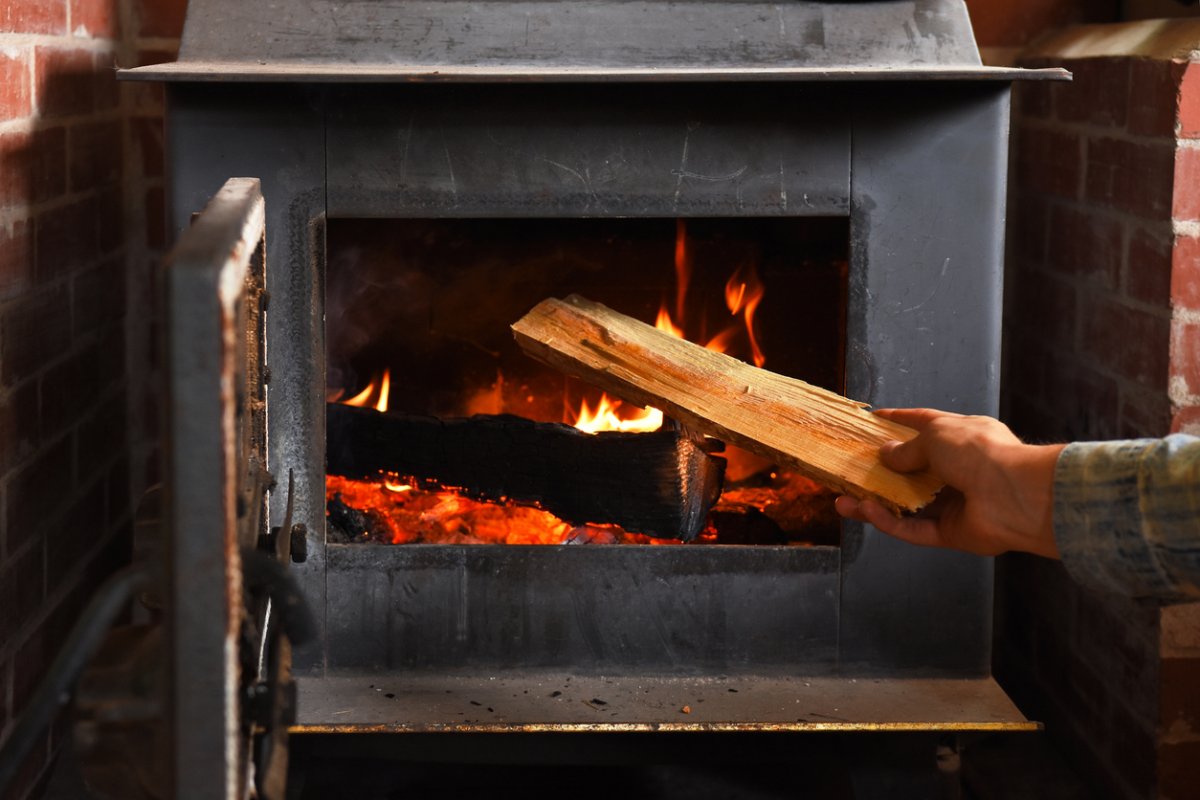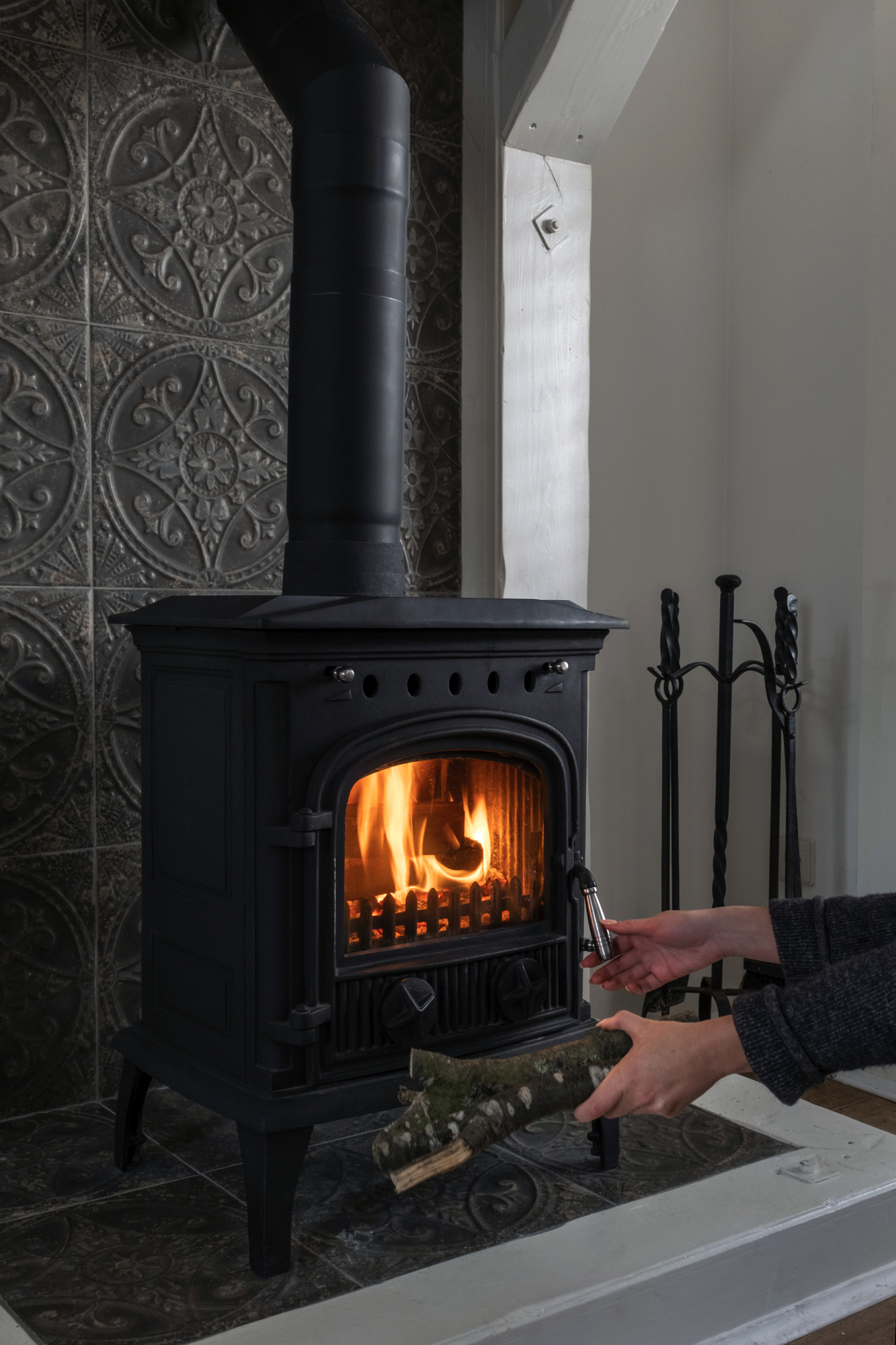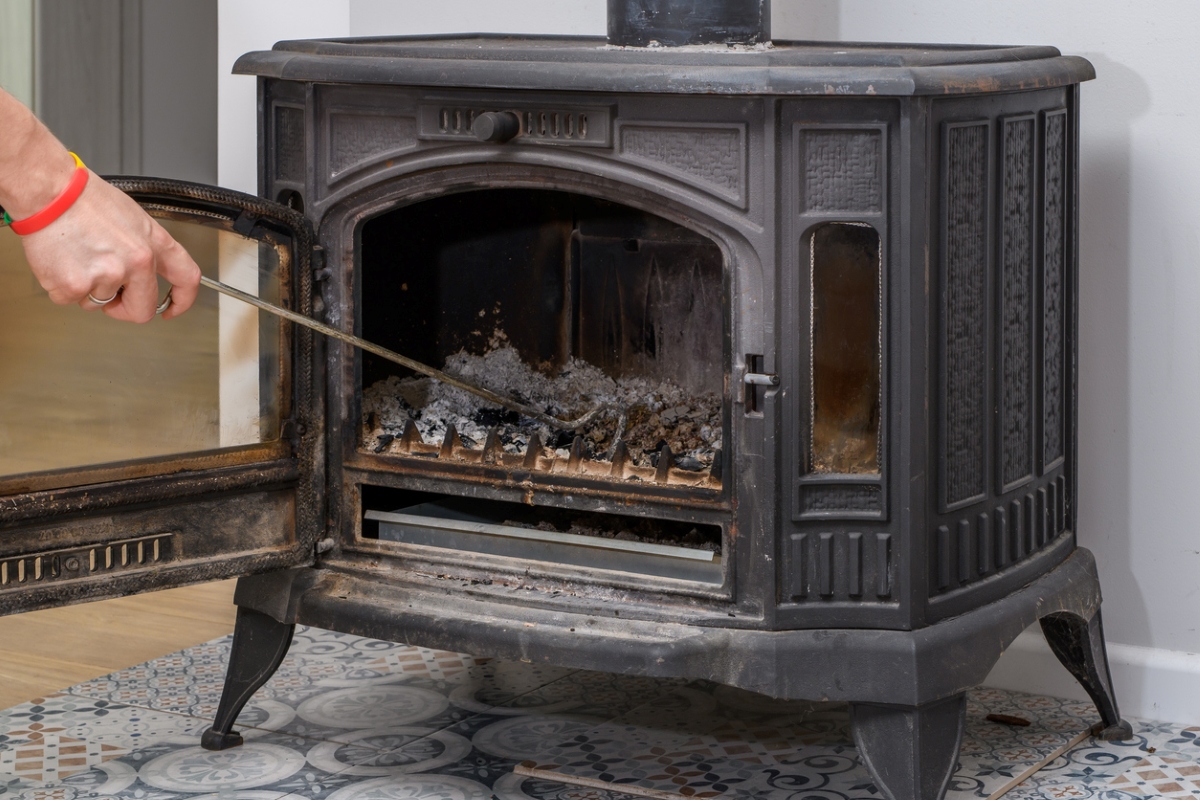

We may earn revenue from the products available on this page and participate in affiliate programs. Learn More ›
Recently, you were visiting friends, and as the night grew colder outside, you were snug indoors, mesmerized by the warmth and glow of your hosts’ wood stove. “Let’s get one!” you exclaimed to your family. As charmed as you were by the stove, your partner and children were even more so. A wood stove: What a good idea!
But is it really such a good idea? As with so many other things relating to the home, it depends. Before you go shopping for a new heating apparatus, learn whether wood stove heat will suit your home and family.
How does a wood stove work?
Wood stoves made of metal have been around for more than 400 years, and while they’ve become ever more efficient, the way they work hasn’t changed much: The homeowner places logs into the firebox—the fireproof central “belly” of the stove. Once ignited, the logs burn in this closed, controlled environment, with air from vents feeding the flames. The stove radiates its heat into the room, while smoke and other waste products vent through a pipe to the outdoors.
To do its job, a wood stove needs to get hot, typically between 500 and 800 degrees Fahrenheit. It’s important to maintain this middle ground. When temperatures are too low, the stove doesn’t generate enough heat, and the pipe doesn’t get hot enough to burn off creosote. If this byproduct of combustion is allowed to build up, it can lead to fires. At the other extreme, stove temperatures that are consistently too high can cause components to warp or crack.
The Pros and Cons of a Wood-Burning Stove
There are good reasons that we moved beyond wood heat long ago. For those of us who enjoy our modern comforts, heating the house with a wood stove would be a monumental inconvenience. For others, however, a wood stove offers the chance to heat the home in a way that emphasizes self-reliance and independence. Which camp do you fall in? Weigh the pros and cons before you commit to warming your home with wood stove heat.
Pros
- In areas where wood is dependably available at low cost, heating your home with a wood stove can save money over a gas or oil system, particularly if you’re able to harvest your own firewood.
- Unlike fossil fuels, wood is a renewable resource. For some, that’s reason enough to think seriously about making the switch from a traditional oil- or gas-fueled system.
- Particularly if you’re using a wood stove as the sole source of home heating, wood heat provides a way to decrease your reliance on the grid.
- Wood heat is deeply satisfying on a primal level. It offers a connection to the land—and to human history—that simply cannot be matched by a system that’s controlled by a thermostat on the wall.
Cons
- It’s a lot of work to fell trees, saw them into logs, and split those logs into stove-length pieces. There are techniques and best practices here that might take the neophyte several seasons to master. Be realistic about your abilities and tolerance for heavy work.
- Heating the home with a wood stove takes real commitment. For instance, if you’re not willing to bank the stove at night (in essence keeping the fire going), you need to start a new fire every morning.
- In the absence of a backup heating system, there must always be someone at home to tend the fire so the plumbing pipes don’t freeze.
RELATED: So, You Want to… Heat Your House With a Wood Stove
Wood Stove Installation: Cost and Other Considerations

A wood stove can be a beautiful way to both amp up your home’s ambience and lower your heating costs. In fact, according to Rich Steiner of The Fireplace Factory on Long Island in New York, homeowners who install a wood-burning stove can save between 400 and 1,000 gallons of heating oil per year. Consumers will find a range of models to choose from, including small-, medium-, and large-duty stoves. “There are even units certified for mobile homes,” Steiner says. But before you rush out to buy, here are a few additional considerations worth noting:
- Permits: You will need to obtain a permit from your local building office.
- Stove cost: Prices vary widely, from about $400 at the extremely low end to $4,000 at the high end, depending on size, materials, style, quality, and special features.
- Installation cost: Buying the stove is just the beginning. You also need to factor in the cost of a wood stove pipe to carry smoke up through the interior of the space as well as a chimney pipe for venting through the wall or, ideally, the roof to the outside. “Piping and labor can end up being more than the price of the stove itself,” Steiner cautions.
- Clearances: Because wood stoves are extremely heavy and get very hot, placement and installation can be complicated. The stove should sit close to the center of the space to be heated and away from exterior walls. You’ll also need a heat shield—metal, brick, stone, tile, or some other noncombustible surface—behind the stove. Stove and pipes must be situated at least 3 feet away from combustible items like furnishings, curtains, and firewood, and at a safe remove from unprotected walls. There are also minimum ceiling heights; check the manual for specific measurements.
- Hearth: The floor below the stove must be covered with noncombustible material, such as brick, ceramic tile, concrete, or stone, and the floor itself may need to be reinforced to handle the weight of the stove and the platform or hearth below it.
- Homeowners insurance: Talk with your insurance company before you move forward with wood stove installation. Insurers may require professional installation or inspection, and homes that use wood stoves as the sole heating source may be ineligible for coverage.
- Bedrooms: Check local building codes before putting a wood-burning stove in a bedroom. As well, installation instructions from many manufacturers specifically state that their wood-burning stoves should not be installed in sleeping quarters.
- Federal tax credit: If you opt for a high-efficiency stove, you may qualify for a federal tax credit. As Steiner notes, “A lot of today’s stoves achieve 75 percent efficiency or better.”
- Pro or DIY installation? Given the requirements and variables, wood stove installation costs vary widely, from about $325 to more than $4,000. While a competent and experienced DIYer may be able to take on the job, wood stove installation is best left to professionals.
RELATED: 10 Home Heating Mistakes That Spike Your Utility Bills
How to Use a Wood Stove

The first step in figuring out how to use a wood-burning stove should always be to consult the manual for the stove you own. However, here is some general advice to introduce you to the basics of wood stove ownership.
How to Select Wood
When you’re using a wood stove, it’s crucial to burn only seasoned wood—in other words, wood that has been aged and dried. (If you’re not sure about the wood, use a moisture meter.) Hardwoods like oak, ash, and maple are best. Properly seasoned softwoods may also be an option, although they burn fast and might be best suited as kindling. If you own a multifuel stove, you can burn various mineral fuels like anthracite coal in addition to wood.
RELATED: The Best Moisture Meters, Tested and Reviewed
How to Start a Fire
To get a fire going in a wood stove, open up the damper, put crumpled newspaper at the bottom of the stove, add kindling, and place logs on top. Light the paper and give the kindling a chance to catch. Keep the door open, watching carefully for wayward sparks, until the logs are burning brightly. Once you have a good fire going, close the door and keep it closed unless you’re adding logs to the fire. Many stove owners, especially those with newer models, recommend building the fire in reverse, starting with logs and then placing kindling and newspaper above. Whichever process you use, never overload the firebox; to maintain a hot fire, air needs to be able to circulate.
How to Handle Ashes
You should maintain a bed of ashes at the base of the firebox, typically around ¾ of an inch (check the manufacturer’s instructions). Periodically shovel out excess ash, leaving the larger bits of unburnt wood. (Of course, put this task off until the ashes have cooled down.) If your wood stove is equipped with an ash pan, you just need to push the ash through the grate into the pan below. Always dispose of ashes in a metal container with a tightly fitting lid, and take it outside the house, safely away from any combustible material. After ashes have cooled for several days, they can be added to the trash or saved to use around the house.
RELATED: 20 Surprising Ways You Can Use Ashes From Your Fire Pit or Fireplace
3 Ways to Circulate Heat From a Wood Stove
A wood stove-based heating system presents many challenges. One that continually frustrates even veteran wood-stove custodians is the art and science of dispersing the heat that the stove produces. Try one of these strategies for helping the heat from your stove reach the far corners of your space.
1. Use a wood stove fan.
A wood stove fan sits on top of the stove and kicks into action when the stove reaches a minimum temperature. The heat of the stove drives a motor that causes the fan blades to turn, pushing that warmth outward into the room.
2. Try a plug-in blower.
A plug-in blower is an electric-powered fan that installs on the wood stove (different models fit different stoves) and pushes heat away from it.
3. Set up a few fans.
To get the warm air really flowing, many wood stove owners position stand-alone fans strategically throughout the house. Fans that are mounted high, such as ceiling fans and small doorway fans, can be effective at pushing heated air to cooler areas farther from the wood stove, while a box fan placed on the floor in a colder area can push cool air toward the stove.
Wood Stove vs. Fireplace: Which is right for you?

When most of us hear the word “fireplace,” we picture an open hearth in the living room or a stone chimney billowing smoke into the evening. We cherish the charming vision of cozying up to a blazing fire, yet the aesthetic value of a fireplace vastly outweighs its heat production. In fact, fireplaces are notoriously inefficient. Just like an open window, the typical fireplace rapidly leaks heated air (air you’ve paid to heat) out of the house.
If you’re considering the relative merits of a wood stove vs. a fireplace, note that a wood stove has some distinct advantages. Like a romantic hearth, a wood stove offers something beautiful to gaze at, but unlike the typical fireplace, it’s a source of heat that doesn’t seriously compromise your home’s energy efficiency. If you’ve always wished that your home had a fireplace, or if you’re looking for an improvement over your existing fireplace, it might be time to look into the beauty and functionality of a wood stove. To get you started on the search, consider an EPA-certified wood stove from Ashley Hearth. The brand was among our top picks in our researched guide to the best wood stoves.
Keep in mind that while a wood stove can be a viable sole heating solution for homes in some parts of the country, it more commonly serves as a companion to an existing gas- or oil-fueled system. What you ultimately decide depends largely on what you want to get out of the wood stove, and what you’re willing to put into it.
